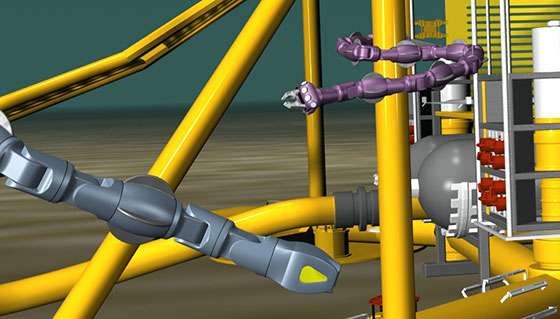A disruptive solution for underwater inspection and maintenance in the form of a swimming robot.
Mention snake-like and robot in the same sentence, and many people find the words inspire thoughts of nightmares and disgusting sights. In Norway, though, a robot development that features a snake-like structure draws positive thoughts about sleek movements and contributions to efficiency in a subsea environment.
The robot moves in and out of structures in carrying out various inspection tasks in the undersea world. Kongsberg has posted on YouTube its videos showing the swimming robot with thrusters and without.
This is what happens when there is good mix of expertise in a collaborative effort. The snake robot is a result of a collaboration of technology company Kongsberg Maritime with a company founded by academics from the Norwegian University of Science and Technology, Eelume, and energy company, Statoil. The swimming Eelume robot was designed to be slender and flexible, able to access confined areas that are difficult to reach with existing technology.
The goal in making the swimming robots has to do with subsea maintenance—namely for inspection and "light intervention," a term used by the news release.
The payoff in using these subsea robots amounts to reduced costs related to subsea inspection, maintenance and repair operations. How so? "The idea is to let these robots do inspection and light intervention jobs on the seabed, reducing the use of large and expensive vessels," said Kongsberg.
Eelume's site said, "As existing subsea infrastructure is ageing, the demand for maintenance will increase. At the same time new installations are more complex due to increased depth and more challenging reservoirs. Subsea costs have tripled since 2005." Also, said Eelume, surface vessel-supported ROV operations for inspection, maintenance and repair (IMR) are time consuming and expensive, mainly driven by vessel cost.
How this will work: The news announcement said the robots will be permanently installed on the seabed. They will carry out both planned and on-demand inspections and interventions. Sample tasks would be visual inspection, cleaning, and adjusting valves and chokes. Jon Fingas in Engadget also brought home the advantages: "The plan is to permanently install these robots on the seabed, where they'll ideally cover the majority of tasks. If all goes well, companies with sea-based operations (such as oil rigs and wind farms) won't need to roll out human-operated vehicles unless there's a serious problem."
What are some key attributes of this snake-like robot? Popular Science contributor Kelsey Atherton had details: "At its head, there's a light and a grasper, which would allow the robot to turn dials, pull levers, or otherwise manipulate objects under the sea like a disembodied diver's arm. That makes it especially useful for inspecting and repairing oil rigs, or other underwater structures."
More information: www.km.kongsberg.com/ks/web/no … 02DCDA6?OpenDocument
© 2016 Tech Xplore























